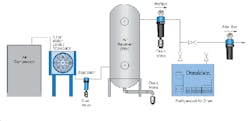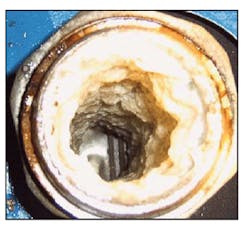Most manufacturing plants use compressed air in their operations for pneumatic tools, valves, motors, brakes, and instrumentation. Typically an air dryer is used after the compressor to reduce the moisture in the compressed air lines. Filters are commonly installed to remove aerosol contaminants from the compressed air, but are the best filters being used and are they installed in the best locations for purifying the air?
Oil-flooded vs. oil-free filtration
Oil flooded screw compressors are most often used because they are reliable, require little maintenance, and provide cost effective service, but oil flooded compressors introduce contaminant into the compressed air — approximately 2 to 5 mg of compressor oil per normal cubic meter of compressed air.
Compressor oil and atmospheric dust must be removed from the compressed air to prevent the formation of corrosive and flow restricting sludge deposits. If left unfiltered, the contaminants in the air can damage pneumatic machinery resulting in production downtime and loss of company time and money. The contaminants also present a health hazard to pneumatic tool operators.
Filtering compressed air can be very simple and cost effective. Coalescing filters will remove oil mist from compressed air and automatic drain valves can remove the liquid condensate in a trouble-free manner. The only maintenance cost is to change out the filter elements when they become plugged with excessive dust.
An oil flooded compressor with proper filtration is more cost effective than an oil-free compressor. In 95% of the installations, aerosol filtration is sufficient. In the remaining 5% of the installations an activated carbon filter placed after the air dryer is required to provide compressed air of equal quality to the oil-free compressor.
System-wide filtration keeps it clean
Aerosol filtration is required upstream of the compressed air dryer, after the dryer, and downstream at each point-of-use in the air distribution system. Liquid and particulate aerosols are removed before the air dryer to prevent adsorbent fouling in desiccant dryers (see Figure 1) and to prevent fouling of the heat exchanger tubes in refrigeration air dryers, Figure 2. Adsorbent fines from the desiccant dryer, as seen in Figure 1, and water mist from the refrigeration air dryer, Figure 2, are removed from the compressed air system by a downstream filter.
Corrosion products and scale from the distribution piping are removed by point-of-use filters installed throughout the manufacturing plant to prevent damage to the pneumatic machinery and contamination of the manufactured products. The compressed air is provided virtually contamination-free.
In high purity compressed air systems, a 2- or even 3-stage prefiltration system is required upstream of the air dryer. The first stage filter is an open structure low pressure loss filter designed to remove 90% of the fine dust and oil mist. The final filter has a 99.99998% removal efficiency based on 0.01 µm size particles to prevent contamination of the air dryer. The filters are designed for low pressure loss to prevent excessive costs in manufacturing operations. Older style filters added pressure losses of 5 to 10 psid, but new designs such as the Donaldson Ultra-Filter with lyophobic (liquid repelling) media have been designed for a differential pressure of less than 2 psid.
An example of the need for filtration before a compressed air dryer is shown in Figure 3. A refrigeration type air dryer was installed without the benefit of prefiltration. Within a month, the inlet heat exchanger was plugged with "white sludge," a mayonnaise-like emulsion of aerated compressor oil and water. After retrofitting the dryer with a coalescing prefilter, the problem was eliminated.
High quality compressed air filtration is not a luxury. It is an essential element in a well run, effective, manufacturing operation.
Don White is Chief Engineer and Tina Pocrnich is Product & Engineering Manager at Donaldson Co. Inc., information call them at (952) 887.3131 or visit www.donaldson.com.




